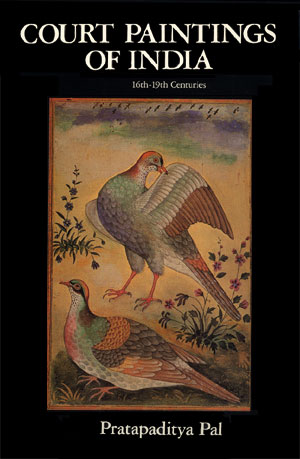Court Paintings of India
Preface and Acknowledgements
Court Paintings of India
Table of Contents
0 Preface & Acknowledgements
1 Introduction
2 Techniques and Practices
3 The Visual Revolution
4 Mughal Paintings
5 Deccani Paintings
6 Rajput Paintings in the Plains
7 Rajput Painting in the Hills
8 Notes
List of Illustrations
Bibliography
Index
This book is about pictures-generally referred to as miniatures- rendered between the sixteenth and nineteenth centuries in India, primarily for the courts of the Muslim and Hindu emperors and kings. Although art has always remained a prerogative of royalty in India, never before in its history was the interest in art and aesthetic so vital a part of court culture as it was during this period. Around 1560 the Mughal Emperor Akbar, in emulation of his contemporary Persian monarchs, established an atelier for producing richly illustrated books. This imperial workshop became as much a state concern as any other organ of government or culture. His son Jahangir was perhaps the first real royal aesthete and critic (in the modern Western sense). In his appreciation of painting, he was no less than a Vasari, a Ruskin or a Berenson. Under the sensitive eyes of these emperors, a distinct style of painting was developed that has come to be known universally as the Mughal or Moghul style.
Among the earliest and most notable European connoisseurs of Mughal painting was the seventeenth century Dutch painter Rembrandt. That Mughal paintings were also appreciated in European courts is evident from the fact that one of the rooms in the Schoenberg palace in Vienna was decorated with original Mughal miniatures. These sparkling paintings, small in size but rich in imagination, have continued to be appreciated in Europe and America, as is evident from the fact that they still command the highest prices among all forms of painting created in the Indian subcontinent. It must be added though that by contrast with European and American paintings they are still much undervalued. It is almost ironical that at a sale a few years ago a Rembrandt drawing of a Mughal painting commanded a far greater price than most original Mughal pictures have ever done.
In emulation of the Mughal overlords, other monarchs in India, both Hindu and Muslim, also became avid patrons of painting. It became fashionable in the seventeenth century to retain court artists, and thus a school of painting under strong Mughal influence came into existence that was characterized at the turn of the century as "Rajput" by Ananda K. Coomaraswamy. Although all Rajput princes (or for that matter all Mughal rulers) were not equally interested in painting- some doubtless were simply imitating their imperial masters-on the whole, there was a genuine desire to enrich the cultural experience of the courts by patronizing painting. Some Rajput monarchs such as Sawant Singh of Kishangarh, Balawant Singh of Jammu or Sansar Chand of Kangra were real enthusiasts and aesthetes. In any event, artists working for the Rajput courts produced a vast quantity of paintings, which are stylistically different from the Mughal pictures, but no less evocative of the life and times of one of the most remarkable periods in Indian history.
The majority of the paintings illustrated in this book belong to a single collection. In order to survey the story of Indian painting of the period from a broader perspective than would have been possible through a single private collection (no matter how great and diversified), I have selected a few important and representative pictures from other collections, both private and public. In recent years the study of Indian art, especially in America, has become so specialized that there are scholars today who know everything there is to know about a single school or even a single manuscript. It would be easy for them to find fault with some of my attributions or sweeping generalizations, but I must admit that even if I miss a tree or two, I much prefer to look at the forest as a whole.
In writing this book I have been helped wholeheartedly by many friends and colleagues and it is a pleasure to acknowledge my indebtedness to them. Three brothers, Ravi, Navin and Vinit Kumar Jain, have always been extremely helpful, courteous and informative and have contributed much to make this a beautiful book. As a matter of fact, I admire Navin Kumar's courage in investing so much money in these hard days for publishers to print so lavish a book on Indian painting. To my knowledge no book on the subject has ever been published that includes so many colour plates. It is my sincere hope that scholars, students and collectors will appreciate his effort to reach a wider public.
Lively discussions with both Doris Wiener and Bashir Mohammad, who kindly reviewed my attribution of the pictures, have been of considerable help. Both my colleagues Drs. Robert Brown and Sheila Canby read the drafts of the manuscript with their characteristic patience and cheerfulness, and needless to say, much improved the text. I am also grateful to Dr. Canby, Dr. V.C. Ohri, and Shahrokh Mahboubian for reading the Persian inscriptions. Among other colleagues I must mention Amy G. Poster and Robert Skelton for their help with slides and transparencies. I wish also to thank Dr. Earl Powell III and the Trustees of the Los Angeles County Museum of Art, the Trustees of the Brooklyn Museum and of the Victoria and Albert Museum, my friend Edwin Binney 3rd, and the noted Indian collectors Gopi Krishna Kanoria and his son Vinod Krishna for allowing me to reproduce two of their finest paintings. Vinod Kanoria has been especially helpful in providing information about their paintings.
As usual, Dixie Fusillo prepared the typescript with her fastidious skill, while my family's contribution is far too subtle and personal to be stated in public; nevertheless, I am grateful to them.
